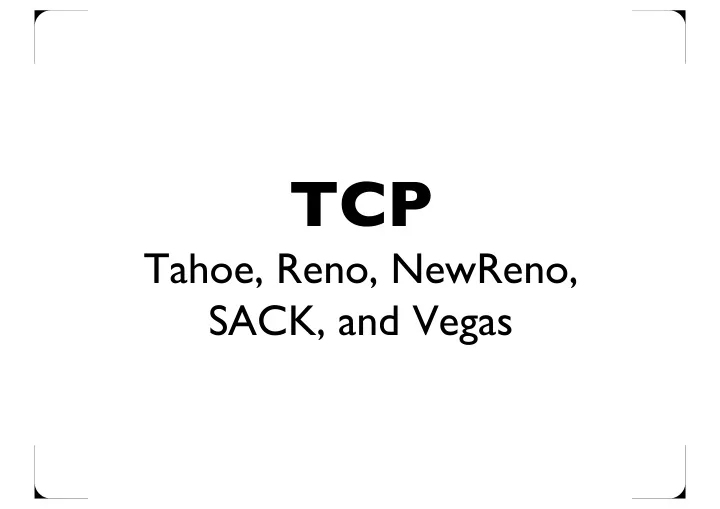

TCP Tahoe, Reno, NewReno, SACK, and Vegas
cwnd : congestion window swnd : usable sending window rwnd : advertised receiver’s window ssthresh : slow-start threshold
RFC793
No cwnd On timeout: retransmit swnd = rwnd
TCP Tahoe
new ack: if (cwnd < sstresh) cwnd += 1 else cwnd += 1/cwnd
timeout/3rd dup ack: retransmit all unacked ssthresh = cwnd/2 cwnd = 1
Improving TCP Tahoe: Packets still getting through in dup ack -- no need to reset the clock!
TCP Reno
new ack: if (cwnd < sstresh) cwnd += 1 else cwnd += 1/cwnd
timeout: retransmit 1st unacked ssthresh = cwnd/2 cwnd = 1
3rd dup ack: retransmit 1st unacked ssthresh = cwnd/2 cwnd = cwnd/2 + 3
Fast Recovery: the pipe is still almost full -- no need to restart
subsequent dup ack: cwnd++ new ack: cwnd = ssthresh
Suppose U is lost (oldest unacked) and all other packets are not. At time t, cwnd is W, and packets [U, U+W-1] are in the pipe. U U+W-1 …
Between time t and t+RTT, we would have retransmitted U and received W-1 duplicate ACK. U U+W-1 …
Between time t and t+RTT, the cwnd becomes W/2 + W-1. So we get to send W/2 new packets during the time. (Soon cwnd is going to become W/2 anyway..) U U+W-1 U+W/2+W-1 …
At time t+RTT, we receive ACK for packets [U,U+W-1], set cwnd to W/2. U U+W-1 U+W/2+W-1 …
Simulation of TCP Tahoe/Reno
S1 R1 S2
Entering Exiting queue queue ACKed
Improving TCP Reno: Timeout if multiple losses in a window
TCP NewReno
Idea: stays in fast recovery until all have been ACKed. Partial ACK Fast recovery starts. are the outstanding packets at this time.
Perhaps the next packet is lost?
3rd dup ack: retransmit 1st unacked ssthresh = cwnd/2 cwnd = cwnd/2 + 3 remember highest
subsequent dup ack: cwnd++ “complete” ack: (all are acked) cwnd = ssthresh
“partial” ack: retransmit cwnd = ssthresh (?)
Note : RFC2581/RFC2582 give the accurate/gory details. Simplified version is presented here (eg. cwnd vs FlightSize, update of cwnd upon partial ACK).
TCP SACK
Coarse Feedback
Go-Back-N vs Selective Repeat
Use TCP header options to report received segments.
SACK Blocks : 1st block - report most recently received segments subsequent blocks - repeat most recent previous blocks
pipe : num of outstanding packets in the path. send only if pipe < cwnd
scoreboard : which packets have been received?
3rd dup ack: pipe = cwnd - 3 retransmit 1st unacked ssthresh = cwnd/2 cwnd = cwnd/2 + 3
subsequent dup ack: cwnd++ pipe-- (if send new packet, pipe++)
“partial” ack: retransmit cwnd = ssthresh pipe -= 2
Power of SACK: Which packet has left the network? Where is the gap? Decouple when to send and what to send.
TCP Vegas
So far, packet loss as signal of congestion.
But, already over congested when packets are dropped
What other signals are there?
RTT Load
Expected Sending Rate E = cwnd/BaseRTT
BaseRTT : RTT when no congestion (take min measured RTT in practice)
Actual Sending Rate A = cwnd/RTT RTT :
If (E-A) < alpha cwnd++ else if (E-A) > beta cwnd--
Intuition : (E-A) x BaseRTT represents extra buffers occupied in the network
Picking alpha/beta alpha: small but non-zero to take advantage of available bandwidth immediately. ( = 1/BaseRTT)
Picking alpha/beta beta: beta-alpha should not be too small to prevent oscillation. ( = 3/BaseRTT)
Deployment
Feb 2004
70% SACK capable
Where is TCP Vegas?
Problem 1. Can’t compete with TCP Reno.
Problem 2. Sensitive to RTT estimation.
TCP BIC/CUBIC Linux 2.6.x
Compound TCP MS Windows Vista
Recommend
More recommend